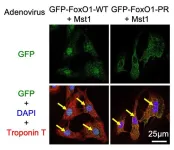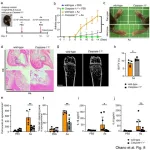The study published in Cancer Cell reveals that a third of the cells in glioma, a type of brain tumor, fire electrical impulses. Interestingly, the impulses, also called action potentials, originate from tumor cells that are part neuron and part glia, supporting the groundbreaking idea that neurons are not the only cells that can generate electric signals in the brain. The scientists also discovered that cells with hybrid neuron-glia characteristics are present in the non-tumor human brain. The findings highlight the importance of further studying the role of these newly identified cells in both glioma and normal brain function.
“Gliomas are the most common tumors of the central nervous system with an estimated 12,000 cases diagnosed each year. These tumors are universally lethal and have devastating effects on neurological and cognitive functions. Previous studies have shown that patient survival outcomes are associated with tumor proliferation and invasiveness, which are influenced by tumor intrinsic and extrinsic factors, including communication between tumor cells and neurons that reside in the brain,” said Dr. Benjamin Deneen professor and Dr. Russell J. and Marian K. Blattner Chair in the Department of Neurosurgery, director of the Center for Cancer Neuroscience, a member of the Dan L Duncan Comprehensive Cancer Center at Baylor and a principal investigator at the Jan and Dan Duncan Neurological Research Institute.
Researchers have previously described that glioma and surrounding healthy neurons connect with each other and that neurons communicate with tumors in ways that drive tumor growth and invasiveness.
“We have known for some time now that tumor cells and neurons interact directly,” said first author Dr. Rachel N. Curry, postdoctoral fellow in pediatrics – neuro oncology at Baylor, who was responsible for conceptualizing the project. “But one question that always lingered in my mind was, ‘Are cancer cells electrically active?’ To answer this question correctly, we required human samples directly from the operating room. This ensured the biology of the cells as they would exist in the brain was preserved as much as possible.”
To study the ability of glioma cells to spike electrical signals and identify the cells that produce the signals, the team used Patch-sequencing, a combination of techniques that integrates whole-cell electrophysiological recordings to measure spiking signals with single-cell RNA-sequencing and analysis of the cellular structure to identify the type of cells.
The electrophysiology experiments were conducted by research associate and co-first author Dr. Qianqian Ma in the lab of co-corresponding author associate professor of neuroscience Dr. Xiaolong Jiang. This innovative approach has not been used before to study human brain tumor cells. “We were truly surprised to find these tumor cells had a unique combination of morphological and electrophysiological properties,” Ma said. “We had never seen anything like this in the mammalian brain before.”
“We conducted all these analyses on single cells. We analyzed their individual electrophysiological activity. We extracted each cell’s content and sequenced the RNA to identify the genes that were active in the cell, which tells us what type of cell it is,” Deneen said. “We also stained each cell with dyes that would visualize its structural features.”
Integrating this vast amount of individual data required the researchers to develop a novel way to analyze it.
“To define the spiking cells and determine their identity, we developed a computational tool – Single Cell Rule Association Mining (SCRAM) – to annotate each cell individually,” said co-corresponding author, Dr. Akdes Serin Harmanci, assistant professor of neurosurgery at Baylor.
“Finding that so many glioma cells are electrically active was a surprise because it goes against a strongly held concept in neuroscience that states that, of all the different types of cells in the brain, neurons are the only ones that fire electric impulses,” Curry said. “Others have proposed that some glia cells known as oligodendrocyte precursor cells (OPCs) may fire electrical impulses in the rodent brain, but confirming this in humans had proven a difficult task. Our findings show that human cells other than neurons can fire electrical impulses. Since there is an estimated 100 million of these OPCs in the adult brain, the electrical contributions of these cells should be further studied.”
“Moreover, the comprehensive data analyses revealed that the spiking hybrid cells in glioma tumors had properties of both neurons and OPC cells,” Harmanci said. “Interestingly, we found non-tumor cells that are neuron-glia hybrids, suggesting that this hybrid population not only plays a role in glioma growth but also contributes to healthy brain function.”
“The findings also suggest that the proportion of spiking hybrid cells in glioma may have a prognostic value,” said co-corresponding author Dr. Ganesh Rao, Marc J. Shapiro Professor and chair of neurosurgery at Baylor. “The data shows that the more of these spiking hybrid glioma cells a patient has, the better the survival outcome. This information is of great value to patients and their doctors.”
“This work is the result of extensive equal collaboration across multiple disciplines – neurosurgery, bioinformatics, neuroscience and cancer modeling – disciplines strongly supported by state-of-the-art groups at Baylor,” Deneen said. “The results offer an enhanced understanding of glioma tumors and normal brain function, a sophisticated bioinformatics pipeline to analyze complex cellular populations and potential prognostic implications for patients with this devastating disease.”
Other contributors to this work include Malcolm F. McDonald, Yeunjung Ko, Snigdha Srivastava, Pey-Shyuan Chin, Peihao He, Brittney Lozzi, Prazwal Athukuri, Junzhan Jing, Su Wang, Arif O. Harmanci and Benjamin Arenkiel. The authors are affiliated with one or more of the following institutions: Baylor College of Medicine, the Jan and Dan Duncan Neurological Research Institute at Texas Children’s Hospital and University of Texas Health Science Center, Houston.
This work was supported by grants from the NIH (R35-NS132230, R01NS124093, R01CA223388, U01CA281902, R01NS094615, 5T32HL92332-15, F31CA265156, and F99CA274700). Further support was provided by NIH Shared Instrument Grants (S10OD023469, S10OD025240, P30EY002520) and CPRIT grant RP200504.
###
END

